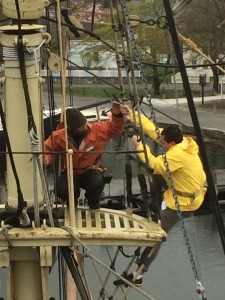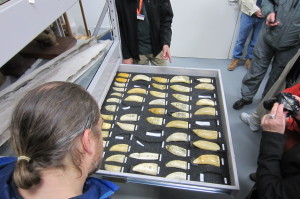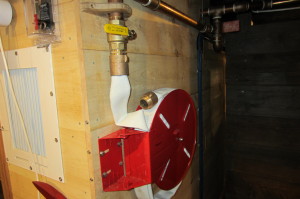The US Coast Guard publishes something called “Merchant Vessels of the United States”, searchable through their Maritime Information Exchange. It’s a directory of merchant ships over about 5 tons in size. (Smaller vessels that aren’t included in MVUS may be registered by states, rather than by the federal government.) Originally, it was in print, and many copies are still available in libraries or through online sources (here’s one from 1897). Then it was published as a CD-ROM, and then USCG made a database out of it, and put it online.
USCG used to have static, ship-specific links to the database, so you could follow a link that would take you right to the entry about the ship. I discovered some time ago that those weren’t working, and eventually I contacted USCG, and got a reply from them that, yes, static links were no longer available.
I had to decide what to do, and I realize I’d made a bit of a mistake in being too caught up on the static links. If you know that a database mentions a vessel, and you still need to search for it once you get to the database, that’s still far better than not knowing at all. Then, while preparing the updated file for import, I discovered that the Office of Science and Technology, of NOAA Fisheries, publishes its own version of the same database, but with vessel-specific links! So I changed what I was doing, and modified the links so they’d point to NOAA’s version of the database.
I will soon remove the old links to the USCG database, and I haven’t yet decided if I should add an updated version of that database, even though one must still do a search for the ship there. If the information is exactly the same as what appears in the NOAA version, I might not add those links. Thoughts?
Anyway, as part of this work, I noticed that many ship names are used over and over in this database. I thought I’d take this opportunity to determine the most popular vessel names in the US.
Here are some caveats: This data is based on information compiled from the USCG MVUS database. It’s not perfect. Some people put “MV” or “SS” or other terms in front of their ship names, which they really shouldn’t do. Others (many others) start their ship name with “The ”, which I also think they shouldn’t do. (That said, my brother built a rowboat for our father, and I carved a name plate for it, and we called it “The Prelude” – with the article – because it was a reference to, among other things, Wordsworth’s poem of that name [pdf]. So clearly at least some people specifically intend to include an article. Most, however, don’t.)
Also, I didn’t combine different spellings of the same name, like “Meant II Be”, “Meant 2 Be”, and “Meant To Be”. Ship names are obviously very popular places for puns, like “Naut On Call”, and they should be left as such. I also did not combine “Nauti Boy”, “Nauti Buoy”, “Nauti Boys”, “Nauti Boyz”, “Nauti Bouys”, etc., into one name…
With all that said, here are the 100 most popular vessel names, including the number of vessels with that name, from the 365,846 named vessels in the US Coast Guard’s Merchant Vessels of the United States database:
| Vessel Name |
Occurrences |
| Serenity |
417 |
| Freedom |
382 |
| Liberty |
329 |
| Osprey |
306 |
| Second Wind |
289 |
| Destiny |
285 |
| Andiamo |
262 |
| Dream Catcher |
247 |
| Spirit |
245 |
| Odyssey |
243 |
| Carpe Diem |
232 |
| Island Time |
232 |
| Escape |
231 |
| Pegasus |
231 |
| Blue Moon |
230 |
| Morning Star |
226 |
| Obsession |
216 |
| Orion |
216 |
| Island Girl |
209 |
| Voyager |
195 |
| Grace |
193 |
| Serendipity |
191 |
| Legacy |
189 |
| Time Out |
188 |
| Escapade |
185 |
| Tranquility |
185 |
| Happy Ours |
183 |
| Summer Wind |
183 |
| Aurora |
174 |
| Phoenix |
171 |
| Free Spirit |
169 |
| Double Trouble |
168 |
| Harmony |
167 |
| At Last |
164 |
| Patriot |
164 |
| Magic |
163 |
| Sandpiper |
163 |
| Relentless |
162 |
| Southern Cross |
162 |
| Halcyon |
159 |
| Mariah |
159 |
| Amazing Grace |
157 |
| Pelican |
154 |
| Endless Summer |
153 |
| Calypso |
152 |
| Whisper |
151 |
| Encore |
148 |
| Imagine |
148 |
| Pura Vida |
148 |
| Seas the Day |
148 |
| Impulse |
147 |
| Eagle |
146 |
| North Star |
144 |
| Zephyr |
144 |
| Wanderer |
143 |
| Ariel |
142 |
| Great Escape |
142 |
| Quest |
141 |
| Raven |
141 |
| Cool Change |
140 |
| Prime Time |
140 |
| Second Chance |
138 |
| Camelot |
136 |
| Hakuna Matata |
136 |
| Mirage |
136 |
| My Way |
136 |
| Panacea |
134 |
| Windsong |
134 |
| About Time |
133 |
| Valkyrie |
133 |
| Perseverance |
132 |
| Journey |
131 |
| Valhalla |
131 |
| Puffin |
129 |
| Patience |
128 |
| Dream Weaver |
126 |
| Restless |
125 |
| Gypsy |
124 |
| Renegade |
124 |
| Black Pearl |
123 |
| First Light |
123 |
| Sanctuary |
122 |
| Sundance |
122 |
| Independence |
121 |
| Resolute |
121 |
| Dulcinea |
120 |
| La Dolce Vita |
120 |
| Sea Hawk |
120 |
| Islander |
119 |
| Moondance |
119 |
| Sea Breeze |
119 |
| Sea Ya |
119 |
| Dragonfly |
118 |
| Liquid Asset |
118 |
| Aquaholic |
117 |
| Dolphin |
117 |
| Oasis |
117 |
| Shearwater |
117 |
| Adagio |
115 |
| Sea Horse |
115 |



























